Payment Processing
Mastercard Refinement Boosts Small Enterprises

Did you realize that small businesses represent a large part of the global economy, making up over 90% of all businesses worldwide? These small-scale endeavors are essential for creating jobs, fostering innovation, and driving economic growth. Yet, many encounter challenges that impede their expansion and long-term success.
This is where Mastercard comes in, with its unwavering commitment to empowering small enterprises and strengthening organizations. Through its refined strategies and support, Mastercard is paving the way for small businesses to thrive in the digital age.
Key Takeaways:
- Small enterprises represent over 90% of businesses worldwide.
- Mastercard’s refinement efforts aim to strengthen and empower small enterprises.
- Mastercard’s support helps small businesses thrive in the digital age.
- Small enterprises play a crucial role in job creation and economic growth.
- Mastercard is committed to the success of small enterprises.
The Mastercard Business Model
The Mastercard Business Model focuses on partnering with financial institutions to provide network payment cards for consumers. These cards, also known as open loop, carry Mastercard’s logo and are issued by member banks. The process of a payment transaction involves the customer making a payment through their Mastercard, which is authenticated by the merchant and forwarded to the acquirer. Mastercard acts as the facilitator, submitting the transaction to the issuer for authorization, and ensuring the funds are transferred to the merchant’s account.
Revenue Streams of Mastercard
Mastercard, as a leading payment network, generates revenue through various channels. These revenue streams include:
- Domestic assessment fees: Issuers or acquirers pay these fees based on the dollar volume of card activities within the same country. This fee structure ensures that Mastercard receives compensation for facilitating transactions within a specific national market.
- Cross-border volume fees: These fees are charged on dollar volume activities for transactions where the merchant’s country differs from the issuer’s country. Cross-border transactions involve additional complexities, and Mastercard levies fees to cover the costs associated with facilitating these international payments.
- Transaction processing revenue: Mastercard earns fees for transaction authorization, clearing, and funds settlement. As a payment network, Mastercard plays a crucial role in ensuring secure and efficient transactions, and these fees contribute to its revenue.
- Rebates and incentives: Mastercard offers variable or fixed payments to customers as part of rebate programs or incentives. These payments are made to encourage card usage and promote customer loyalty.
- Other payments: In addition to the above revenue streams, Mastercard also generates income from consulting services, data analytics, and loyalty solutions. These additional offerings provide value-added services to clients and contribute to Mastercard’s overall revenue.
Overall, Mastercard’s revenue streams are diverse and encompass various aspects of its operations. The company’s ability to generate revenue from different sources enables it to maintain its position as a leading player in the payment industry.
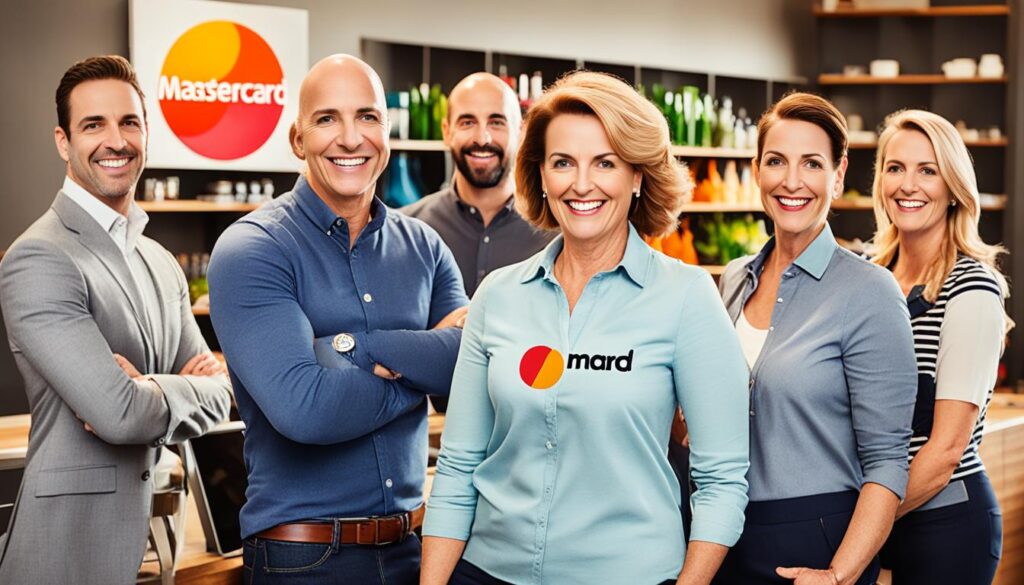
| Revenue Stream | Description |
|---|---|
| Domestic assessment fees | Fees paid by issuers or acquirers based on the dollar volume of activities on cards within the same country. |
| Cross-border volume fees | Fees charged on dollar volume activities on cards where the merchant and issuer’s country differ. |
| Transaction processing revenue | Fees for transaction authorization, clearing, and funds settlement. |
| Rebates and incentives | Variable or fixed payments made to customers as part of rebate programs or incentives. |
| Other payments | Fees for consulting, data analytics, and loyalty solutions. |
Mastercard’s Customer Segments
Mastercard serves a diverse range of customer segments, catering to the unique needs of each group.
Individuals
For individuals, Mastercard offers the convenience and financial control of using their cards for everyday purchases. Whether it’s buying groceries, dining out, or booking travel, individuals can rely on Mastercard for secure and seamless transactions.
Small and Medium Businesses
Small and medium businesses receive valuable support from Mastercard in promoting their business and reaching a wider audience. Through their partnerships, Mastercard helps businesses manage social media marketing, build customer loyalty, and access valuable insights to enhance their operations.
Government and Public Sector
The government and public sector rely on Mastercard for efficient procurement, financial aid disbursement, and digital payment solutions. By leveraging Mastercard’s secure and reliable network, government agencies can streamline their processes and ensure the seamless flow of funds.
Large Enterprises
Large enterprises partner with Mastercard to benefit from secure and efficient payment solutions. Mastercard provides tailored solutions for large enterprises, enabling them to optimize their payment processes, manage expenses, and enhance their overall financial management.
Banks and Credit Unions
Banks and credit unions collaborate with Mastercard to provide safe and reliable means of payment to their customers. Through this partnership, financial institutions can offer their customers access to a wide range of Mastercard products, ensuring convenience and security in their financial transactions.

Mastercard’s commitment to serving these customer segments is driven by the goal of providing inclusive financial solutions and empowering businesses and individuals in the digital age.
Loyalty and Personalization Consulting
Mastercard’s Loyalty and Personalization Consulting practice is dedicated to helping businesses cultivate authentic and long-lasting customer relationships. With a team of experienced professionals, they offer deep expertise, customer-focused solutions, and invaluable insights. By implementing strategies that drive customer engagement and foster loyalty, businesses can leverage technology and data to optimize their offerings and enhance customer lifetime value.
Delivering Customer-Centric Solutions
Mastercard’s Loyalty and Personalization Consulting practice focuses on understanding the unique needs and preferences of each customer. By analyzing data and customer insights, they provide tailored solutions that resonate with individuals, strengthen relationships, and drive customer satisfaction.
Optimizing Customer Lifetime Value
Through personalized marketing initiatives and loyalty programs, Mastercard’s consulting practice enables businesses to maximize customer lifetime value. By leveraging advanced analytics and predictive modeling, businesses gain a deeper understanding of customer behavior, allowing for targeted offers and promotions that result in increased loyalty and repeat business.
Mastercard’s Loyalty and Personalization Consulting practice offers businesses a comprehensive approach to building strong customer relationships. Their expertise and insights help businesses understand their customers better, optimize their offerings, and enhance customer loyalty. By leveraging technology and data-driven strategies, businesses can unlock the full potential of their customer relationships and achieve sustainable growth.
Benefits of Mastercard’s Loyalty and Personalization Consulting
Partnering with Mastercard’s consulting practice offers numerous benefits for businesses:
- Improved customer retention and loyalty
- Enhanced customer experience through personalized engagement
- Increased customer lifetime value by optimizing offerings
- Access to advanced data analytics and predictive modeling
- Expert guidance in implementing effective loyalty programs
Mastercard’s consulting practice empowers businesses to create meaningful and personalized experiences that resonate with customers, fostering long-term loyalty and sustainable growth.
A Success Story in Loyalty and Personalization Consulting
One example of Mastercard’s success in loyalty and personalization consulting is their collaboration with a global retail brand. By leveraging customer insights and advanced analytics, Mastercard helped the brand design a targeted loyalty program that rewarded customers for their loyalty and incentivized repeat purchases. The results were impressive, with a significant increase in customer retention and higher average transaction values. This success story exemplifies how Mastercard’s consulting services can make a tangible impact on businesses’ bottom line.
Unlocking the Full Potential of Customer Relationships
Mastercard’s Loyalty and Personalization Consulting practice enables businesses to tap into the power of data-driven insights and personalized experiences to cultivate lasting customer relationships. By partnering with Mastercard, businesses can elevate their customer engagement strategies and drive sustainable growth in today’s competitive market.
| Benefits of Loyalty and Personalization Consulting | Value for Businesses |
|---|---|
| Improved customer retention and loyalty | Enhances long-term profitability by keeping customers engaged and loyal. |
| Enhanced customer experience through personalized engagement | Delivers tailored experiences that resonate with customers, fostering satisfaction and loyalty. |
| Increased customer lifetime value by optimizing offerings | Maximizes revenue potential by identifying opportunities to optimize offerings and increase customer loyalty. |
| Access to advanced data analytics and predictive modeling | Allows for data-driven decision-making, enabling businesses to make informed decisions and anticipate customer behavior. |
| Expert guidance in implementing effective loyalty programs | Provides expert advice and support in designing and implementing loyalty programs that drive customer engagement. |

Digital Transformation of Small Business Support
The digital revolution has brought about significant changes in the way small businesses operate and seek support. Today, Micro and Small Enterprises (MSEs) are increasingly relying on digital technologies to enhance their market access, streamline operations, access credit, develop essential skills, and engage with customers online.
Support organizations have recognized the importance of understanding the digital landscape and the specific needs of MSEs. By embracing digital transformation, these organizations can provide effective assistance and empower MSEs to thrive in the digital age.
Digital MSE support encompasses a wide range of tools and technologies that aid small businesses in their growth journey. Here are some key components:
- E-commerce platforms: Online marketplaces and platforms enable MSEs to establish a digital presence and sell their products or services to a broader customer base. These platforms offer easy-to-use interfaces, secure payment gateways, and built-in marketing tools to help MSEs reach their target audience.
- Enterprise software: Digital solutions such as customer relationship management (CRM), accounting, inventory management, and project management software help automate business processes, improve efficiency, and provide accurate insights for informed decision-making.
- Fintechs: Financial technology companies offer digital payment solutions, mobile banking, online lending, and other financial services tailored to the needs of MSEs. These fintech solutions provide convenient access to credit and enable businesses to manage their finances more effectively.
- Online communities: Online forums, social media groups, and communities provide MSEs with opportunities to connect, collaborate, and learn from each other. These communities foster knowledge sharing, provide valuable insights, and offer a support network for small business owners.
The digital transformation of small business support has opened up new possibilities for MSEs, enabling them to compete on a level playing field with larger enterprises. By embracing digital technologies and leveraging the support available, MSEs can overcome common challenges and pave the way for sustainable growth.

Five Forms of Digital MSE Support
When it comes to supporting Micro and Small Enterprises (MSEs) in the digital age, there are five main forms of digital MSE support that can make a significant difference in their success and growth. These forms include:
- Digital Market Access: This form of support helps MSEs transform their operations by moving them online and enabling them to reach new customers and suppliers. Whether through e-commerce platforms or online marketplaces, digital market access provides MSEs with greater visibility and opportunities for growth.
- Digitalizing Operations: Digitalizing operations involves leveraging technology to improve efficiency and productivity. By implementing digital tools and solutions, MSEs can streamline their processes, automate repetitive tasks, and optimize resource allocation. This not only saves time and resources but also enables them to focus on strategic growth initiatives.
- Digital Credit: Digital credit plays a crucial role in providing operational capital and liquidity to MSEs through digital channels. With digital credit solutions, MSEs can access funds quickly and conveniently, allowing them to seize opportunities, fulfill orders, and manage cash flow effectively.
- Digital Skill Building: In the era of digital transformation, acquiring the necessary digital skills is vital for MSEs to thrive. Digital skill building support equips MSEs with the knowledge and expertise to utilize digital technologies effectively. This includes training programs, workshops, and resources that empower MSEs to embrace the digital landscape and leverage it to their advantage.
- Online Engagement: Online engagement plays a crucial role in informing and inspiring MSEs. Through relatable content, online communities, and networking opportunities, MSEs can gain insights, learn from peers, and foster meaningful connections. Online engagement platforms create a supportive environment where MSEs can share experiences, seek advice, and stay updated on industry trends.
By leveraging these forms of digital MSE support, businesses can unlock new opportunities, enhance their competitiveness, and navigate the digital landscape with confidence.
Five Pathways to Transformative Digital MSE Support
To achieve transformative digital MSE support, organizations should consider five pathways that enable small enterprises to leverage digital capabilities effectively. By adopting an intentional and purposeful approach, pinpointing strengths and weaknesses, integrating local offerings, and fostering communities, MSEs can thrive in the digital age.
Catering to Digital Capabilities and Contexts
Organizations must recognize that MSEs vary in their digital capabilities and contexts. By understanding the digital maturity level of each MSE and tailoring support accordingly, transformative outcomes can be achieved. Providing resources and training that match the specific needs of MSEs enables them to harness digital technologies and unlock new opportunities. Whether it’s implementing e-commerce platforms, adopting enterprise software, or partnering with fintechs, organizations can empower MSEs to navigate the digital landscape with confidence.
Being Intentional and Purposeful
“The key to effective digital MSE support lies in being intentional and purposeful.”
Support organizations should adopt an intentional and purposeful approach when addressing the unique needs of MSEs. By understanding their aspirations, challenges, and goals, organizations can tailor their offerings to provide the most relevant and impactful support. This may include targeted training programs, access to mentorship networks, or customized advisory services. By meeting MSEs’ needs with intentionality, support organizations enable them to grow and succeed in the digital era.
Pinpointing Strengths and Weaknesses
Identifying the strengths and weaknesses of MSEs is essential for providing tailored support. By conducting thorough assessments and diagnostics, support organizations can gain insights into each MSE’s specific areas of expertise and improvement. This enables the development of targeted intervention strategies, such as skill-building programs or business process optimization. Pinpointing strengths and weaknesses allows support organizations to address gaps effectively and enhance MSEs’ digital capabilities.
Integrating Local Offerings to Leverage Complementarities
Transformative digital MSE support involves integrating local offerings to leverage complementarities. Support organizations should collaborate with local stakeholders, such as government agencies, industry associations, and community organizations, to create a comprehensive ecosystem of support. This integration enables MSEs to access a wide range of resources, including funding opportunities, networking events, and industry-specific expertise. By leveraging complementarities within the local ecosystem, support organizations can provide MSEs with holistic and tailored support.
Forming Regional and Global Communities
Forming communities—both regionally and globally—is crucial for fostering collaboration and knowledge sharing among MSEs. By facilitating connections between MSEs, support organizations create opportunities for peer learning, best practice sharing, and collective problem-solving. Communities provide a platform for MSEs to exchange ideas, seek advice, and gain inspiration from one another. Through these networks, MSEs can build relationships, expand their networks, and stay updated on the latest industry trends.

Transformative digital MSE support thrives when organizations prioritize catering to MSEs’ digital capabilities and contexts, adopt an intentional and purposeful approach, pinpoint strengths and weaknesses, integrate local offerings, and foster communities. By embracing these pathways, support organizations empower MSEs to navigate the digital landscape with confidence and unlock their full potential.
The New Digital Small Business Builder Ecosystem
The evolving landscape of digital MSE support has given rise to a vibrant and dynamic ecosystem for small business builders. This ecosystem encompasses a wide range of organizations, from startups to larger support institutions, all working together to enhance the growth and resilience of micro and small enterprises (MSEs) in the digital age.
By understanding the digital technologies that MSEs utilize and prioritizing their needs, these supporters can effectively create impactful and sustainable solutions. The emphasis is on harnessing the power of digital technologies to empower MSEs and drive their success in the competitive business landscape.
Within the digital small business builder ecosystem, MSEs can access a wealth of resources geared towards fostering their digital transformation. These resources encompass various aspects of business development and enable MSEs to leverage digital technologies for greater efficiency, reach, and profitability.
Impact and Sustainability
The impact of this digital small business builder ecosystem is far-reaching. By embracing digital technologies and receiving tailored support, MSEs can experience significant improvements in productivity, market access, and customer engagement. This, in turn, contributes to their long-term sustainability and competitiveness in the digital marketplace.
Furthermore, the digital small business builder ecosystem promotes collaboration and knowledge sharing among MSEs. Through partnerships and communities, MSEs can learn from each other, share best practices, and collectively navigate the challenges and opportunities presented by the digital landscape.
“The digital small business builder ecosystem empowers MSEs to leverage digital technologies effectively, driving their growth, and enabling them to thrive in the digital age.” – Thorsten Meyer
In summary, the digital small business builder ecosystem revolutionizes how MSEs navigate the complexities of the digital landscape. By bringing together different stakeholders and resources, this ecosystem fosters the sustainable growth of MSEs, positioning them for success in the digital economy.

Conclusion
The digital transformation of small enterprise support, driven by Mastercard’s refinement efforts, has revolutionized and strengthened organizations nationwide. Small enterprises (MSEs) now have unprecedented access to digital tools and comprehensive support across various aspects of their business, from market access to skill building.
The support ecosystem for MSEs continues to evolve, with a deep understanding of their unique digital capabilities and specific needs. This intentional and tailored approach ensures that MSEs receive customized solutions that address their individual challenges and propel their growth in the digital age.
As a key player in the support ecosystem, Mastercard’s commitment to inclusive growth and financial management has played a pivotal role in empowering small enterprises. By facilitating digital transformation and providing MSEs with the resources they need to thrive, Mastercard has fostered an environment where these businesses can flourish and contribute to the economy on a larger scale.
In this ever-changing landscape, MSEs can rely on the ongoing refinement of Mastercard’s offerings and the continued growth and evolution of the support ecosystem. Together, these factors create a synergistic environment for MSEs to thrive and succeed in the digital era, driving innovation, economic growth, and job creation for the broader community.
How Can Mastercard’s Refinement Benefit Small Enterprises in Credit Card Processing?
Mastercard’s refinement can optimize business credit card processing by offering small enterprises faster, more secure transactions and access to valuable insights. This can help them streamline operations and improve customer experience, ultimately leading to increased sales and growth opportunities.
FAQ
What is the Mastercard Business Model?
The Mastercard Business Model focuses on partnering with financial institutions to provide network payment cards for consumers. These cards, also known as open loop, carry Mastercard’s logo and are issued by member banks. The process of a payment transaction involves the customer making a payment through their Mastercard, which is authenticated by the merchant and forwarded to the acquirer. Mastercard acts as the facilitator, submitting the transaction to the issuer for authorization, and ensuring the funds are transferred to the merchant’s account.
How does Mastercard generate revenue?
Mastercard’s revenue is generated from various sources. Domestic assessment fees are paid by issuers or acquirers on the dollar volume of activities on cards within the same country. Cross-border volume fees are charges paid on dollar volume activities on cards where the merchant and issuer’s country differ. Transaction processing revenue includes fees for transaction authorization, clearing, and funds settlement. Rebates and incentives are variable or fixed payments made to customers upon agreement. Other payments include fees for consulting, data analytics, and loyalty solutions.
Who are the customer segments served by Mastercard?
Mastercard serves a diverse range of customer segments. Individuals benefit from the convenience and financial control of using Mastercard cards for everyday purchases. Small and medium businesses receive support in promoting their business, managing social media marketing, and more. The government and public sector utilize Mastercard for procurement, financial aid, and digital payments. Large enterprises partner with Mastercard for secure and efficient payment solutions. Banks and credit unions collaborate with Mastercard to provide safe means of payment.
What does Mastercard’s Loyalty and Personalization Consulting practice offer?
Mastercard’s Loyalty and Personalization Consulting practice assists businesses in fostering authentic and lasting customer relationships. Their team of experts provides deep expertise, customer-focused solutions, and unrivaled insights. Through strategies that drive customer engagement and foster loyalty, businesses can leverage technology and data to optimize their offerings and improve customer lifetime value.
What is digital MSE support?
Digital MSE support refers to the assistance provided to Micro and Small Enterprises (MSEs) in the digital age. It includes various forms such as e-commerce platforms, enterprise software, fintechs, and online communities, which enable MSEs to access markets, improve operations, obtain credit, build digital skills, and engage with other businesses and resources online.
What are the five forms of digital MSE support?
The five main forms of digital MSE support are digital market access, digitalizing operations, digital credit, digital skill building, and online engagement. Digital market access helps MSEs move their operations online and reach new customers and suppliers. Digitalizing operations involves using technology to improve efficiency and productivity. Digital credit provides operational capital and liquidity to MSEs through digital channels. Digital skill building helps MSEs learn and utilize digital technologies effectively. Online engagement informs and inspires MSEs through relatable content and online communities.
What are the five pathways to transformative digital MSE support?
The five pathways to transformative digital MSE support involve catering to MSEs’ digital capabilities and contexts, being intentional and purposeful in addressing specific needs, pinpointing strengths and weaknesses to provide tailored support, integrating local offerings that leverage complementarities, and forming regional and global communities to foster collaboration and knowledge sharing.
What is the digital small business builder ecosystem?
The digital small business builder ecosystem encompasses a wide range of organizations, from startups to larger support institutions, all working towards enhancing Micro and Small Enterprise (MSE) growth and resilience in the digital age. By understanding the digital technologies used by MSEs and putting their needs at the forefront, supporters in this ecosystem create impactful and sustainable solutions for small businesses.
Payment Processing
Plastic Card Control Tools in Commerce Sector

Were you aware that plastic card transactions made up more than 70% of all non-cash payments in the United States last year?
Plastic card control tools are changing how we pay and get paid. They are key in business and banks for quick payments and better security. This article talks about their benefits, key features, and the top card management systems. We’ll also look closely at CardEze Cloud Suite CMS. It’s a top system with great features for managing payments. Let’s learn how these tools make commerce safe and efficient!
Key Takeaways:
- Plastic card transactions accounted for over 70% of all non-cash payments in the United States last year.
- Plastic card control tools revolutionize the commerce sector by streamlining transactions and enhancing security.
- Card management systems simplify payment processing, expense tracking, spending control, and report generation.
- Popular card management systems offer a range of features to manage payment card orders, inventory, and card replacement.
- CardEze Cloud Suite CMS provides advanced integration capabilities and a comprehensive set of features for organizations.
Benefits of Card Management Systems
Card management systems help businesses and financial institutions a lot. They make managing payment cards easier and more secure. This helps businesses run better.
These systems are great for processing payments fast. Businesses can handle card transactions smoothly. This makes customers happy and operations more efficient.
They also help track expenses well. This lets businesses see where their money goes. They can then use their budgets more wisely.
Card management systems let businesses control spending too. They can set limits on cards. This helps keep spending under control.
Generating reports is another plus. These systems provide important information on card use and financial transactions. These reports are very useful for checking finances and following rules.
These systems are also good for giving out employee rewards. Companies can use them to give bonuses. This way, tracking and managing rewards is easier.
These systems also increase security in business. They follow security rules and keep card info safe. They help prevent fraud by allowing the deactivation of stolen cards and setting spending limits.
They make managing money and improving security easier for businesses in the commerce sector.
Features of Card Management Systems
Card management systems have many features that make managing cards easy and safe. They help businesses and banks manage their payment cards well. These systems do a lot to help.
One cool feature is making different types of payment cards. This includes virtual, debit, credit, and prepaid cards. It lets organizations give the right payment tools to their people.
They also let you make payment cards special. You can add names, numbers, or logos. This makes each card unique to the owner or company.
You can set limits on how much money can be spent with these cards. This helps keep spending under control. It makes sure people don’t spend too much.
Another feature is quickly turning off stolen cards. Deactivating stolen cards keeps them safe. It follows security rules and keeps private info safe.
These systems are great for watching expenses and controlling spending. They also make reports. This info helps companies manage their money better. It helps in making good financial decisions.
Some advanced systems work with other apps to update card info. This keeps card details accurate and current. It makes things run smoothly.
In conclusion, card management systems are very helpful. They make managing payment cards secure and efficient. With these systems, organizations can issue, personalize, and track their cards easily. They also meet security rules and offer great reports.
Popular Card Management Systems
Businesses and banks use special systems to handle their card-related tasks. These systems help with keeping track of card orders, controlling spending, and making reports. They make processing payments and tracking expenses easier.
Some well-known systems are:
- System A
- System B
- System C
- System D
These systems are liked because they are powerful and easy to use. They help companies manage their cards more easily. This makes tracking expenses and controlling spending simpler.
The cost of these systems varies. For small businesses, prices start between $29 and $149 a month. Larger companies with more needs have special pricing options.
It’s vital to think about what your company needs before choosing a system. Consider how many cards you handle and your inventory size. Picking the right system makes managing cards more efficient and secure.
Streamline Payment Processing and Enhance Control
“With popular card management systems, businesses can streamline payment processing and gain better control over their financial transactions.” – John Smith, CEO of Company X
These systems make payment processing smoother and more efficient. They automate card issuing and offer customizable payment methods. They also work with famous payment gateways.
They also give companies more control by setting spending limits and monitoring transactions in real time. Companies can quickly deactivate cards that are lost or stolen. This reduces fraud risks and makes commerce safer.
Using these systems improves how companies process payments. This leads to better financial management and success.
How Card Management Systems Improve Purchase Management
Card management systems are key for handling payments and tracking expenses. They help improve purchase management in buying and selling. With special features to boost procurement and operations, these systems give businesses tools to enhance purchasing. Let’s see how card management systems can change purchase management:
1. Setting Limits and Tracking Payments
These systems let companies set spending limits on cards. This ensures employees stick to budgets and company spending rules. By tracking payments and details, businesses can see transactions in real-time. This helps them understand buying patterns and trends.
2. Generating Detailed Reports
Creating detailed reports is easy with card management systems. They gather transaction data and expense info to make thorough reports. By looking at these reports, companies can find ways to improve. They can work better with suppliers, get good prices, and make choices based on data.
3. Automating Recurring Payments
Managing recurring payments can be hard and take a lot of time. Card management systems make these payments automatic. This cuts down on manual work and mistakes. With this automation, companies can spend time on more important things.
4. Managing Manual Supplier Payments
For companies still paying suppliers by hand, card systems offer a better way. They make it easier and safer to handle these payments. This way, businesses cut down on paper, avoid mistakes, and work more efficiently.
5. Control Over Unauthorized Expenditures
A major advantage of these systems is stopping unauthorized spending. They let businesses stop or limit certain transactions. This means only approved purchases are made. It helps stop fraud and lowers the risk of unauthorized spending.
6. Simplified Management of Travel and Expense Cards
For issuing travel and expense cards, these systems make things easier. They let companies control these cards all in one place. Businesses can set spending limits, approve certain costs, and keep an eye on transactions. This makes things clearer, cuts down on work, and tracks expenses better.
In all, card management systems make purchase management smoother. They offer features that improve buying, increase control, and make things more efficient. These advanced tools help with setting limits, tracking payments, making reports, automating payments, handling supplier payments, controlling spending, and managing travel cards. Using a card management system can change purchase management. It pushes companies towards more success in the buying and selling world.
The Role of Card Management Systems in Enhanced Security
Card management systems are vital for security in commerce. They work hard to protect cardholder info. This is because they follow tough security rules and privacy laws.
One key part of these systems is stopping stolen cards. This stops card theft or fraud right away. By quickly stopping these cards, companies and banks can prevent wrong transactions.
Another great feature is setting spending limits. This lets companies control how their cards are used. They can make sure all transactions are within set limits. This helps avoid spending too much or misuse of funds.
Card management systems also watch how cards are used. They let companies see card activity in real time. This helps spot unauthorized or strange transactions quickly. By watching transaction patterns, companies can fight fraud better.
These systems also help safely give out new cards. By automating card issuance, they cut down on risks. This means less chance of mistakes or security issues.

Card management systems make buying and selling safer. They’re crucial for keeping information safe. They help businesses and banks stay safe from fraud and security problems. By using these systems, they protect themselves and their customers.
Card Management Systems: A Closer Look
Card management systems are powerful tools. They help manage the life of a card, from start to finish. This includes requests, approvals, issuance, and expiry.
In the finance world, **credit card management systems** are key. They make operations smooth and keep things safe. But their use isn’t just for credit cards. Schools and businesses use them too, for managing IDs and more.
These systems do more than the basics. They work with other apps to keep card info up to date. This means fewer mistakes and better management.
They save time by automating complex tasks. This makes managing cards much easier for organizations.
Universities and Corporations: Identification Card Management Systems
In schools and businesses, ID card systems are vital. They keep things running smoothly and enhance security. These systems handle everything related to ID cards.
By working with access systems, they ensure safety. They also consolidate printing, making card making easy and secure.

Highlighting Advanced Integration Capabilities
- Integration with third-party applications for seamless updates across systems
- Integration with access control systems for secure entry management
- Integration with printing systems for efficient card issuance
With these advanced features, card systems boost efficiency and security. They ensure everything works together well in an organization.
Introducing CardEze Cloud Suite CMS
CardEze Cloud Suite (CardEze CS) improves efficiency and connectivity. It helps with ID card operations. It connects well with other apps.
This system handles both physical and digital IDs. So, it stays useful as tech changes. Moving to digital IDs like NFC is easy.
CardEze CS acts as a glue that binds together best-of-breed solutions, enabling organizations to choose specialized applications without sacrificing horizontal integration.
CardEze CS handles every step of the card’s life. You can request, approve, issue, monitor, and even reissue cards. It gives full control over cards.
Key features of CardEze CS include:
- It manages the whole life of a card. This includes issuing and taking care of cards.
- It has rules for issuing cards. These rules help with compliance and make issuing smoother.
- It’s cloud-based, so you can access it from anywhere. This makes it flexible and convenient.
- Your data is safe. CardEze CS uses strong security to protect cardholder info.
- It integrates well with other systems. This adds more functions and automation.
- It provides great reports and tracks changes. These features offer valuable insights and ensure compliance.
CardEze CS in Action: A Case Study
A multinational company, XYZ Corporation, used CardEze CS. They have many offices and employees. They needed a better way to handle ID cards and connect with other apps.
With CardEze CS, XYZ Corporation could:
- Issue ID cards quickly and efficiently. This saved them time and resources.
- Connect seamlessly with other systems. This reduced duplicate data and increased efficiency.
- Keep employee information safe. Their data was secure thanks to CardEze CS.
- Get better reports and follow regulations. They understood their card management better and stayed compliant.
Overall, CardEze Cloud Suite CMS is a total solution for ID card management. It integrates well, is future-ready, and connects easily with apps. CardEze CS boosts efficiency, security, and compliance.
Benefits and Applications of CardEze Cloud Suite CMS
CardEze Cloud Suite CMS helps organizations a lot. It makes ID card programs better, faster, and safer. With this, card applications and joining processes are smooth.
“CardEze CS has truly transformed our ID card management. It streamlines our operations and enhances our overall security. The benefits are incredible!” – John Smith, CEO of XYZ Corporation
CardEze CS connects easily with other apps. This reduces manual work and boosts efficiency. It works with both local and remote image capture, too. This means cards can be printed and given out in many places.

CardEze CS lets people handle their cards by themselves. This is a big plus. It saves organizations time and money.
Moreover, CardEze CS works well with old systems and new apps through REST APIs. This lets organizations keep using their current tools while adding new card features.
The benefits and applications of CardEze Cloud Suite CMS can be summarized as follows:
- Efficient ID card issuance programs: CardEze CS revitalizes the process of issuing identification cards, delivering efficiency and security.
- Seamless connectivity: The integration capabilities of CardEze CS allow for seamless connectivity with other applications, reducing manual processes and increasing efficiencies.
- Flexible image capture: Whether it’s local or remote image capture, CardEze CS supports both, enabling centralized or distributed printing and issuance of cards.
- Secure self-service options: CardEze CS enables cardholders to update and manage their own cards securely, saving time and resources.
- Integration with legacy systems and third-party applications: CardEze CS offers seamless integration with legacy systems and third-party applications through REST APIs, maximizing the organization’s existing infrastructure.
- Enhanced visibility and compliance: The reporting and audit trail functionalities of CardEze CS provide enhanced visibility and ensure compliance with regulatory requirements.
CardEze Cloud Suite CMS is a top-notch card management system. It meets organizations’ needs today and plans for their future. Its benefits include efficient card issuance and easy self-service for users. It also integrates well with other systems.
Conclusion
Plastic card control tools are key for buying and selling. They change how transactions happen and boost security. With these systems, businesses can better handle payments and keep track of their spendings.
Some top systems help manage card orders and replacements. The CardEze Cloud Suite CMS, for instance, connects with other apps. It also keeps data safe. This makes these tools vital for staying ahead, safe, and efficient.
Nowadays, using these tools is a must in commerce. They make payments better and keep things compliant with security rules. Businesses must use these advances to keep operations smooth and protect against fraud.
FAQ
What is the role of plastic card control tools in the commerce sector?
What are the benefits of card management systems?
What features do card management systems offer?
What are some popular card management systems in the market?
How do card management systems improve purchase management?
How do card management systems enhance security in the commerce sector?
What are card management systems and how do they work?
What is CardEze Cloud Suite CMS?
What are the benefits and applications of CardEze Cloud Suite CMS?
Why are plastic card control tools important in the commerce sector?
How Can I Utilize Plastic Card Control Tools to Reduce My Service Bill?
By utilizing plastic card control tools, you can effectively manage and reduce your service bill. These tools allow you to set spending limits, track expenses, and monitor usage, helping you to stay within budget and lower your overall costs. Take control of your finances with plastic card control service bill solutions.
Source Links
Payment Processing
Credit Card Insights: Information You Need Here!

Did you realize that making intelligent decisions can increase approval rates for credit cards by 5-7%? It is crucial for credit card issuers to utilize reliable and precise data to achieve this. By doing so, you can gain a deeper understanding of your customers and make more informed decisions. Allow me to provide guidance on expanding your pool of applicants, enhancing your marketing strategies, and improving customer satisfaction.
Key Takeaways:
- Expand your credit card prospect pool by utilizing utility, pay TV, wireless phone, and other payment data.
- Improve marketing and portfolio management with AI, trended data, and powerful analytics.
- Personalize offers to enhance the consumer experience.
- Make more confident decisions by understanding a consumer’s history of meeting debt obligations.
- Increase approved credit card applicants by 5-7% with improved decision-making strategies.
The Benefits of Augmenting Scores with Alternative Data
Adding alternative data like utility bills and phone payments to credit scores has big perks. It helps credit card companies find more people and make smarter choices. This means more people get approved for credit cards.
Using alternative data improves marketing and how companies manage their credit cards. With AI and analytics, they can predict things better. This leads to offers that match what customers really need and want.
“Alternative data can transform the way credit decisions are made, providing deeper insights into a consumer’s creditworthiness and behavior,” says Sarah Thompson, a credit analyst at XYZ Financial Services.
Knowing if someone pays their bills on time is key. Adding all kinds of payment data helps see someone’s financial habits better. This way, companies can offer the right credit amount, which lowers risks and supports wise borrowing.
To visually showcase the benefits of using alternative data, look at the following table:
| Benefits of Augmenting Scores with Alternative Data |
|---|
| Expanded credit card prospect pool |
| More confident origination decisions |
| Increased number of approved credit card applicants |
| Enhanced marketing and portfolio management |
| Improved predictiveness enabled by AI, trended data, and powerful analytics |
| Personalized offers and improved decisioning and service |
| Deeper insights into a consumer’s creditworthiness and behavior |
| More accurate assessment of creditworthiness and tailored credit limits |
| Mitigation of risk and encouragement of responsible borrowing |
In conclusion, boosting credit scores with alternative data is very helpful for credit card companies. By including data like utility and phone payments, lenders can reach more people. They also make smarter choices. This means better offers for consumers and safer borrowing.
Understanding Credit Card Basics
Credit cards are important for managing money. They let you borrow funds to pay back later. This is different from debit cards, which use the money you have.
They can help build your credit. Just use them right and pay on time. This helps when you need a loan in the future.
Credit cards make buying things easy, both online and in stores. They come with security. This protects you from scams.
“Credit cards are financial tools that can be beneficial if used responsibly.”
They can also be a backup in emergencies. They provide a safety net for sudden expenses or when you need money fast.
But it’s key to know how they work and what types there are. Avoiding mistakes is also crucial for your money health.
The Types of Credit Cards
Different credit cards meet different needs. Some common types include:
- Rewards Cards: These cards offer points, miles, or cashback rewards for making purchases.
- Balance Transfer Cards: These cards allow you to transfer balances from one card to another at a lower interest rate.
- Cashback Cards: These cards give you a percentage of the purchase amount back as cash rewards.
Knowing the types helps you pick the best one for your goals and lifestyle.
Common Credit Card Mistakes to Avoid
Avoiding common mistakes with credit cards is vital. Watch out for:
- Overspending: Spending too much can lead to debt and stress.
- Carrying a Balance: Not clearing the full balance means paying more interest.
- Missing Payments: Late payments mean fees and hurt your credit score.
Avoiding these errors helps you use cards wisely and avoid money problems.
The Difference Between Debit and Credit Cards
Debit cards and credit cards are two financial tools. They look alike but work differently. They also affect your money in different ways.
Debit cards use your own money from your checking account. You pay directly for things without borrowing. This means you use what you have, avoiding debt.
Credit cards let you borrow money to pay for things. You add what you spend to your card’s balance. You must pay this back, with interest sometimes. They’re flexible and help in urgent situations.
Debit and credit cards are both handy for payments, yet they’re different:
| Debit Cards | Credit Cards |
|---|---|
| Directly deducts money from checking account | Allows borrowing money to make purchases |
| No interest charges | May charge interest on the unpaid balance |
| No borrowing involved | Requires repayment of borrowed funds |
Understanding debit and credit cards is key. Debit cards avoid debt and are simple. Credit cards offer chances to build credit and are flexible.
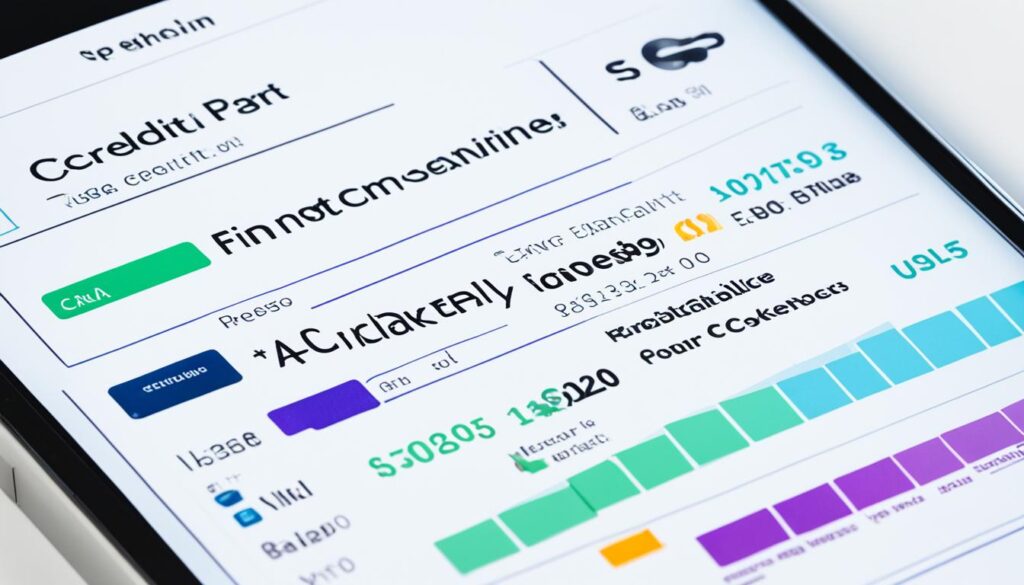
Credit Card Terms and Conditions Explained
Understanding credit card terms is key to using them smartly. By knowing the main terms, you can make wise decisions. This will help you manage your money better.
Credit Limit
Your credit limit is how much you can spend on your card. It’s the largest amount you can borrow. Stay within this limit to avoid extra fees.
Current Balance
The current balance shows what you owe at a certain time. It includes purchases, cash advances, and fees. Pay it off monthly to avoid interest.
Interest Rates
Interest rates show the cost of borrowing money. They are shown as an APR. If you don’t pay in full, interest applies. Different rates might apply for various transaction types.
Knowing these terms helps you use credit cards better. Watch your limit, manage your balance, and know your interest rates. This knowledge is vital.
Now, let’s check out a table with these key terms:
| Term | Definition |
|---|---|
| Credit Limit | The maximum amount of credit available on your credit card. |
| Current Balance | The total amount you owe on your credit card at a specific point in time. |
| Interest Rates | The cost of borrowing money on your credit card, expressed as an annual percentage rate (APR). |
Understanding these terms lets you make smart choices. Always check your card’s specific terms. This helps you know your duties.
Types of Credit Cards
There are many credit cards to choose from. Each card has special features and benefits for your financial needs. You can find a card that gives rewards, helps you combine balances, or offers cash back.
Rewards Cards
Rewards cards give you something for spending money. You can get points, miles, or cashback when you buy things. You can use these rewards for travel, gift cards, or to pay off your card.
Balance Transfer Cards
If you’re dealing with high credit card debt, check out balance transfer cards. They let you move what you owe to a card with low interest, sometimes even 0% APR for a while. This can help you save money and make paying bills simpler.
Cashback Cards
Cashback cards are straightforward and give immediate value. You get part of your spending back in cash. This is a nice way to save money on regular purchases.
“Whether you’re looking to earn rewards, consolidate your balances, or get cash back on purchases, there is a credit card out there for you.”
Knowing about different credit cards can help you pick the best one for you. Look at how you spend money and what you need financially. This will help you find a card that brings the most value to you.
| Type of Credit Card | Key Features |
|---|---|
| Rewards Cards | Earn points, miles, or cashback for purchases |
| Balance Transfer Cards | Transfer balances from high-interest cards to a lower interest rate |
| Cashback Cards | Get a percentage of your purchases back as cash |
Common Credit Card Mistakes to Avoid
Credit cards are useful, but you must avoid mistakes. Knowing these errors can help you stay financially healthy. Let’s look at key mistakes and how to dodge them:
Overspending
Overspending is a major mistake with credit cards. It’s easy to buy too much, especially with a high limit. This can lead to debt and money problems. To prevent this, make a budget and follow it. Only buy what you can fully pay off each month.
Carrying a Balance
Not paying the full amount by the due date is a big mistake. This can cause your debt to grow over time. Always try to pay your balance in full each month. If paying off is hard, look for help or debt consolidation options.
Missing Payments
Skipping payments can really hurt your finances. It leads to late fees and can damage your credit score. To keep from missing payments, use automatic payments or reminders. Being prompt with payments keeps your credit score healthy and gives you more credit options in the future.
Avoid these mistakes to responsibly enjoy credit card perks. Stay disciplined, watch your spending, and keep up with payments.
| Mistake | Consequences |
|---|---|
| Overspending | High-interest debt, financial difficulties |
| Carrying a Balance | Interest charges, increased debt |
| Missing Payments | Late fees, penalty interest rates, credit score damage |
How to Use Credit Cards Responsibly
Using credit cards wisely is crucial for good financial health. It helps you get the most out of them. Follow a few simple rules to use credit cards right and stay safe.
Paying Bills on Time
Paying your credit card bills on time is very important. It helps you avoid late fees and keeps your credit history strong. If you pay late, it hurts your credit score. This makes getting good interest rates harder later on.
Maintaining Low Balances
It’s also key to keep your balances low. Try to use less than 30% of your credit limit. Doing this is good for your credit score. It shows you can manage debt well.
Monitoring Your Credit Score
Watching your credit score helps you understand your finances. It also lets you spot errors or fraud. Many online tools can help you keep track. Knowing your credit score helps you take steps to improve or keep it good.
“Responsible credit card use involves paying bills on time, maintaining low balances, and monitoring your credit score.”
To use credit cards rightly, you need discipline and attention. Make sure to pay bills on time, keep balances low, and watch your score. Credit cards are great tools if used wisely.
| Benefits of Responsible Credit Card Use |
|---|
| Paying bills on time |
| Maintaining low balances |
| Monitoring credit score |

Tips for Choosing the Right Credit Card
Choosing a credit card is a big deal. It’s important to look at things like interest rates, fees, and rewards. These things can help you decide which card is best for you. You want a card that fits your money goals and how you spend.
Interest Rates
Interest rates are super important. They affect how much you pay in extra charges if you keep a balance. Try to find a card with a low rate. This can help you save money over time, especially if you often have a balance.
Fees
Fees are another thing you should check. Cards might have yearly fees, late payment charges, and fees for transferring balances. These fees can really add up, so look for a card with low or no annual fees that suits your budget.
Rewards
Rewards can be great if you pick the right card. Think about what rewards fit your life. Some cards give cashback or points for travel. Pick a card that rewards you for how you already spend money.
“Choosing the right credit card can make a big difference in your financial journey, so take the time to find the one that provides the most value for your specific needs.”
Look at interest rates, fees, and rewards to make a smart choice. Remember, the right card for someone else may not be the right one for you. By comparing different cards, you can find one that meets your financial goals.
| Credit Card Features | Interest Rates | Fees | Rewards |
|---|---|---|---|
| Card A | 15.99% | $0 annual fee | 2% cashback on all purchases |
| Card B | 18.99% | $50 annual fee | 1 mile per dollar spent |
| Card C | 12.99% | $25 late payment fee | 5% cashback on groceries |

Conclusion
Credit cards are helpful and can bring many perks if used right. They help improve credit scores when payment data is used. This lets lenders make better choices and approve more people.
To make smart money choices, know how credit cards work. Also, know the types you can get. Stay away from common mistakes like spending too much, not paying off the balance, and late payments.
Always pay bills on time and keep your balances low. Watch your credit score closely. Pick a credit card wisely. Look at interest rates, fees, and the rewards they offer.
By understanding these pointers and insights, you can use credit cards well. Make choices that match your money goals and what you like.FAQ
How do credit cards work?
What is the difference between debit and credit cards?
What are credit card terms and conditions?
What are the different types of credit cards?
What are common credit card mistakes to avoid?
How can I use credit cards responsibly?
What should I consider when choosing a credit card?
What Information Should I Consider When Choosing a Mastercard Issuer for Credit Card Insights?
When considering the right mastercard issuer choice for credit card insights, it is crucial to examine the card’s interest rates, fees, and rewards program. Additionally, it is essential to research the issuer’s customer service and overall reputation in the industry to make an informed decision.
Source Links
Payment Processing
Choosing the Right Mastercard Issuer is Key
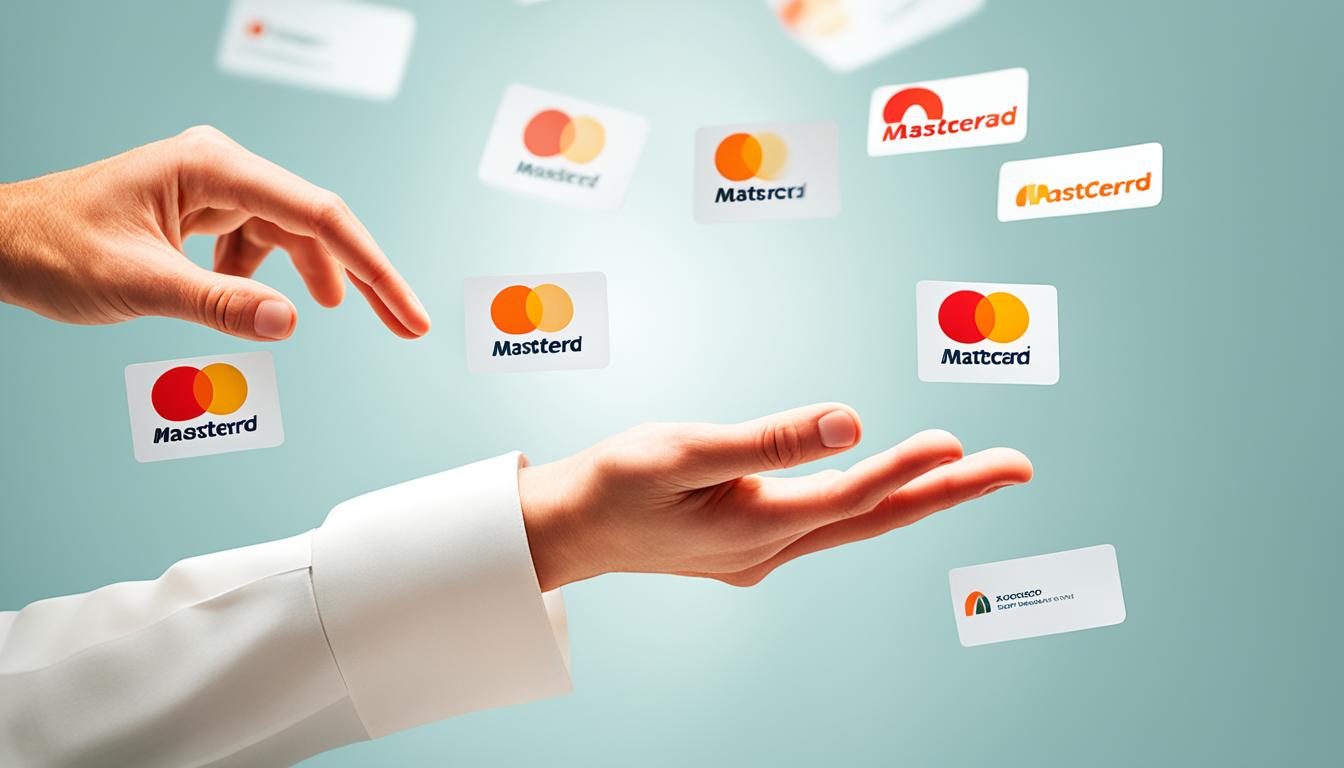
Choosing the correct Mastercard issuer is essential. This decision can make or break your card program’s success and ensure seamless payments for cardholders. It’s a fact!
Many factors are important when choosing a Mastercard issuer. Technology and infrastructure must be reliable. Also, compliance and security are key. They all help in making your card program both healthy financially and convenient.
Key Takeaways:
- Choosing the right Mastercard issuer is essential for the success of your card issuing program.
- Factors to consider include technology and infrastructure reliability, compliance and security, customization and flexibility, scalability and performance, cost structure, innovation and technology roadmap, and customer support and service level agreements.
- The right issuer-processor ensures a seamless payment processing experience for your cardholders.
- Mastercard cards offer exceptional benefits, rewards, services, and spending power, providing the ultimate convenience and financial control.
- Displaying Mastercard branding at points of interaction is important for consistent brand representation and acceptance.
Technology & Infrastructure Reliability
Choosing the right issuer-processor is key. Their technology and structure are very important. As a card issuer, you need to look closely at their tech. You must consider their reliability, size-handling ability, security, and protection of customer data.
A modern and strong structure is vital. It helps an issuer-processor deal with more transactions. It also helps them use new tech and keep customer data safe. Tech problems can upset customers. They can also interrupt your business.
Work with an issuer-processor that values reliable tech. This gives your cardholders a smooth payment process. A good structure handles transactions well. Being able to grow means they can deal with more transactions in the future.
The finance industry must focus on security. An issuer-processor needs strong security to protect customer data. They should use encryption, multi-factor verification, and follow rules.
Good tech structure not only keeps customer data safe. It also boosts your brand and builds trust.
Ask about their plans for disasters. A good disaster recovery plan means they can fix problems fast. This keeps downtime low and business running smoothly.
Advantages of a Reliable Technology & Infrastructure:
- Smooth handling of increasing transaction volumes
- Adaptability to new technologies
- Enhanced security for customer data
- Minimized downtime with robust disaster recovery plans
Choosing a strong issuer-processor is important. It makes payments secure and smooth for your customers. It helps your brand grow and be respected.
| Benefits of Technology & Infrastructure Reliability | Advantages |
|---|---|
| Increased scalability | Ability to handle growing transaction volumes |
| Adaptability to new technologies | Stay ahead of industry advancements |
| Enhanced security | Protection of sensitive customer data |
| Business continuity | Minimized disruptions and downtime |
Compliance & Security
For card issuance, keeping cardholders’ trust is key. As an issuer, it’s your job to pick a processor that follows the rules. This makes sure your cards are safe and reliable.
The Payment Card Industry Data Security Standard (PCI DSS) is very important. It shows how to keep card data safe from thieves. Working with a processor that follows PCI DSS helps prevent data theft.
Cardholder data is super valuable and needs utmost protection. If it gets out, you could lose money and trust. Staying on top of compliance and security means you’re dedicated to protecting your customers.
Securing Customer Data with PCI DSS
PCI DSS makes sure card data is handled safely. You need strong rules, safe systems, and checks on your security. You also must control who can see the data.
Following PCI DSS keeps your customers’ data safe. It shows your card program is built on a strong base. You’re ready to stop, find, and handle security problems.
“Compliance with PCI DSS is not only a regulatory requirement but also a strategic imperative for any card issuer. It’s about protecting our customers’ sensitive data, preserving our reputation, and gaining a competitive edge in the market.”
To boost security, think about using encryption, tokenization, and extra log-in steps. These tools make it tough for bad guys to see cardholder data.
Building Trust and Ensuring Continued Compliance
For card issuers, keeping up with rules and security never stops. You need to keep checking your system to find and fix weaknesses. It’s vital to stay current with security trends to fight new threats.
By focusing on compliance and security, you show you care about your customers’ money safety. Always check your processor’s security steps to keep card data safe.
| Benefits of Compliance and Security: |
|---|
| 1. Protection against data breaches |
| 2. Maintenance of customers’ trust |
| 3. Prevention of financial losses and reputational damage |
| 4. Compliance with industry regulations and standards |
| 5. Competitive advantage in the market |
Customization & Flexibility
Choosing the right issuer-processor for your card program is big. Customization and flexibility are crucial. They help meet your unique needs.
Customization lets you create special loyalty programs and cards. These fit your brand and attract the right customers. You can offer cool rewards, benefits, or promotions. It sets you apart from others.
Flexibility is about tailoring fee structures to your business. It helps in making profits while keeping cardholders happy. You can adjust fees based on different factors.
Integration is also key for smooth operation. Your issuer-processor should easily connect with other systems. This makes things efficient and improves customer experience.
The main aim is to build a card program that reflects your vision. Choose an issuer-processor that values customization and flexibility. This way, you’ll stand out, keep cardholders loyal, and succeed.
| Benefits of Customization & Flexibility | Examples |
|---|---|
| Enhanced brand differentiation | Creating unique card designs and loyalty features that reflect your brand identity |
| Increased cardholder satisfaction | Offering personalized benefits and rewards that cater to cardholders’ preferences and spending habits |
| Optimized revenue generation | Implementing fee structures that align with your business model and maximize profitability |
| Seamless integration with existing systems | Integrating with CRM platforms or mobile banking apps for a unified customer experience |
Scalability & Performance
If your business grows, you will need to process more. So, it’s vital to pick an issuer-processor that can scale up. Scalability means handling more transactions well, without slowing down or crashing.
It’s important to check how well issuer-processors can manage many transactions. Look for those who’ve handled high volumes smoothly. This shows they can keep up with your growing needs while ensuring everything runs smoothly.
Also, think about how they deal with disasters and keep things running. No one wants disasters, but a good plan means you can get back to business fast. Ask about their disaster recovery plans and how they keep your card program up.
Disaster Recovery and Business Continuity
A good issuer-processor needs solid disaster and continuity plans. Plans should have backups and ways to switch over to minimize issues and data loss.
Ask where their servers are too. Depending on your needs, you might want a provider with servers in specific locations. This ensures good performance for your users.
Having strong recovery and continuity plans shows an issuer-processor’s dedication. They ensure your card business keeps going, even when things get tough.
| Key Considerations for Scalability and Performance | Issuer-Processor A | Issuer-Processor B | Issuer-Processor C |
|---|---|---|---|
| Track Record in Handling Peak Transaction Volumes | Excellent | Good | Fair |
| Disaster Recovery and Business Continuity Plans | Robust | Standard | Basic |
| Server Location | Diverse | Regional | Limited |
When you look at scalability, performance, and how they handle disasters, you make sure your issuer-processor can support your growth. This means good service, no matter what happens.

Cost Structure
Understanding the cost structure of a card issuance program is key. The pricing model, setup fees, transaction fees, and hidden costs are vital. Knowing these helps determine overall profitability.
Transparency in cost structure is a must. A good issuer-processor offers a clear pricing model. It shows setup fees and transaction fees with no surprises.
Watch out for hidden costs in the card issuance industry. These can lower profit margins. Reading contracts carefully helps avoid unexpected expenses.
“Transparent pricing is crucial to avoid hidden costs that can erode profit margins.” – John Thompson, Card Issuer
Know your costs to forecast expenses and profits. This knowledge supports smart decisions. It helps your card program succeed in the long run.
Comparative Table: Cost Structure Comparison
| Issuer-Processor | Pricing Model | Setup Fees | Transaction Fees | Hidden Costs |
|---|---|---|---|---|
| Issuer A | Fixed monthly fee | $500 | $0.50 per transaction | No hidden costs |
| Issuer B | Pay-as-you-go | No setup fees | $0.75 per transaction | Potential processing fees |
| Issuer C | Tiered pricing | $750 | $0.30 per transaction | Annual maintenance fees |
Table: A comparison of the cost structures of different issuer-processors. (Data for illustrative purposes only).
Understanding your cost structure is crucial for a profitable card program. Evaluating pricing models, fees, and hidden costs is vital. This ensures financial health and long-term success.

Innovation and Technology Roadmap
Choosing an issuer-processor is important. Innovation and a clear tech plan are key. By working with a forward-thinking firm, card issuers can remain on top. They can use new tech to make customers happy and improve operations.
Innovation lets issuers give top solutions. This includes mobile pay or biometric IDs. These make things easy and fun for customers.
A strong tech plan readies issuer-processors for the future. It means using new tech, better security, and working with others. This makes operations smooth and efficient.
Old systems can slow progress. They may stop issuers from keeping up with market changes. These systems lack the needed flexibility and growth ability. This makes it hard to serve customers well.
When picking an issuer-processor, check their innovation commitment. Look at their tech progress plans. This means seeing their research spending, tech partners, and new solution success.
Advantages of an Innovative Technology Roadmap
- Enhanced customer experiences through innovative features and services
- Operational efficiency achieved through streamlined processes and automation
- Ability to adapt to changing market demands and customer preferences
- Increased competitiveness in the ever-evolving financial industry
- Reduced reliance on manual processes and legacy systems
By embracing innovation and a solid tech plan, card issuers can shine in a fast and digital market.
Customer Support and Service Level Agreements (SLAs)
Good customer support is key in banking. As someone who issues cards, I see the need to check an issuer-processor’s help. It matters to work with ones who offer top-notch support. This ensures problems get fixed fast and well.
When looking at support, speedy answers and know-how matter. Quick help means card users get their issues solved fast. Also, knowledgeable support people can offer better advice. This makes things better for both the card issuer and the users.
It’s smart to set up clear service level agreements (SLAs). SLAs outline what to expect about fixing issues, keeping systems up, and more. They mark a standard for good service. By agreeing on SLAs early, everyone knows what service to expect. This leads to openness and responsibility.
“Responsive and reliable customer support is crucial in the financial industry.”
Why is Customer Support Important for Card Issuers?
For card issuers, great support shows we care about our users. When they have problems or questions, they need to feel valued. By choosing partners that value support, we make sure our users get help. This makes them happy and loyal.
Also, solving issues fast is vital to keep payments smooth. Be it fixing bugs or disputes, quick support helps avoid risks. It keeps our card program running without trouble.
Benefits of Establishing Service Level Agreements (SLAs)
Having clear service level agreements (SLAs) with our partner brings many perks:
- Clearly defined expectations: SLAs make sure both sides know the service level.
- Accountability: SLAs help us check how well the issuer-processor is doing. They make things clear and responsible.
- Issue resolution: SLAs show how to fix problems fast and well.
- System uptime: SLAs tell what system availability to expect. This cuts downtime and issues.
- Improved cardholder satisfaction: Working with an issuer-processor that follows SLAs makes users happier.
Service Level Agreements (SLAs) at a Glance
Here’s what service level agreements (SLAs) usually include:
| Aspect | Description |
|---|---|
| Response times | Defined timeframe within which the issuer-processor must respond to inquiries or issues raised by card issuers. |
| Issue resolution | Guidelines for resolving technical or operational issues efficiently and effectively. |
| System uptime | Defined expected availability of the issuer-processor’s systems to ensure minimal downtime. |
| Expertise | The level of expertise and industry knowledge that the issuer-processor’s customer support team possesses. |

Convenience and Benefits of Mastercard Cards
Mastercard cards bring financial freedom and ease. They come with many benefits, rewards, and services. This makes them perfect for those who want control over their money. Here’s why they stand out:
- Worldwide acceptance: Mastercard lets you buy things and get money anywhere. These cards work in millions of places all over the world. This means you can easily shop and eat out anywhere.
- Direct deduction: Using a Mastercard means money comes straight out of your bank account. This makes buying things easy and smooth. No more carrying cash or watching your credit limit all the time.
- Rewards and benefits: Mastercard gives you lots of rewards and perks. You can get cashback, travel benefits, and special deals. This makes every buy feel special. Enjoy discounts on shopping, dining, and fun, and save money.
- Simple and convenient: Mastercard prepaid and gift cards are great for gifts. They’re easy to use, simple to carry, and accepted everywhere. They’re an excellent gift idea for anyone.
So, if you want day-to-day ease, the option to buy abroad, or great rewards, Mastercard is the answer. Feel the freedom of managing your money with a Mastercard.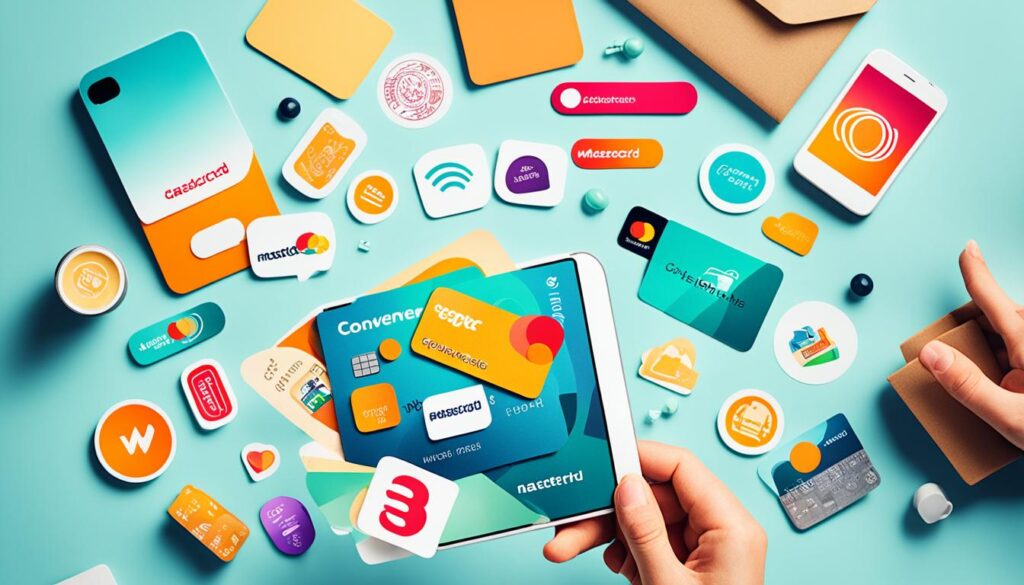
The Power of Convenience
“Mastercard combines worldwide use with direct money taking from your bank. This gives ultimate convenience and control.” – Expert
Unlocking Rewards and Benefits
“Mastercard rewards you every time you spend. Enjoy benefits and discounts that make buying even better.” – Financial Analyst
Displaying Mastercard Branding at Points of Interaction
Displaying Mastercard branding at points of interaction is very important. It helps build trust and recognition. It also makes the shopping experience better for customers.
Mastercard has clear rules for showing their logo at physical and digital shops. It’s key to show the Mastercard logo clearly, no matter if your store is real or online.
Real stores should have the Mastercard logo easily seen on front signs, cash registers, and payment machines. This helps customers quickly see and trust the payment option. It also helps customers decide to buy when they clearly see the logo.
Online shops should show the Mastercard logo clearly on their websites, apps, and during paying. This act adds trust to the site. It also tells customers their payment info is safe.
Following Mastercard’s logo rules is very important. It keeps the brand look the same everywhere, which helps trust in Mastercard. By doing this, shops help to make paying with Mastercard easy and familiar for customers.
Benefits of Displaying Mastercard Branding:
- Increases customer trust and recognition
- Enhances the overall customer experience
- Provides clarity and convenience in payment decision-making
- Reinforces a sense of security and reliability
- Creates a familiar and seamless payment experience
Shops that show Mastercard branding well can use the brand’s power to improve customers’ paying experiences.
| Location | Placement |
|---|---|
| Physical Merchant Locations | Prominently displayed on storefronts, cash registers, and payment terminals |
| Digital Merchant Locations | Displayed prominently on websites, mobile applications, and payment checkout processes |
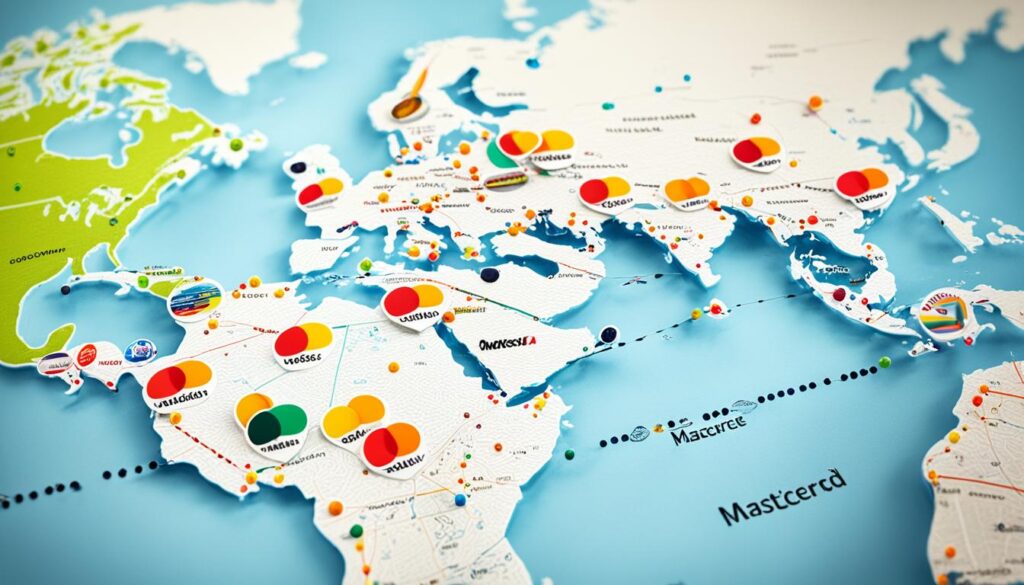
Showing Mastercard branding not only boosts brand recognition but also makes customers feel confident. This leads to more sales and loyal customers. It’s an easy and effective way for shops to show they accept Mastercard. It also makes paying easy for their customers.
Conclusion
Choosing the right issuer-processor is a big decision for your card issuing program. This choice can really make or break your program’s success. It’s crucial to look at things like technology, how well they follow rules, and if they can grow with you. You also want to think about costs, new ideas, and how they help customers.
When you pick an issuer-processor, see if their tech and setup are reliable. Check if they are serious about following rules and keeping things safe. It’s also key to see if they can customize their service for what you need. You should look at how well they can handle growing needs. And don’t forget to check how clear they are about costs.
Working with an issuer-processor that’s always coming up with new ideas can make things better for your customers and your team. Lastly, make sure they offer great customer support. They should have solid plans in place for any problems that come up.FAQ
What factors should I consider when choosing the right Mastercard issuer?
Why is technology and infrastructure reliability important in an issuer?
What compliance and security measures should an issuer-processor adhere to?
Can an issuer-processor provide customization options and flexibility?
How important is scalability and performance in an issuer-processor?
What should I consider when it comes to the cost structure of an issuer-processor?
Should I partner with an issuer-processor committed to innovation and technology advancement?
How important is responsive and reliable customer support in an issuer-processor?
What are the benefits of Mastercard cards?
How important is displaying Mastercard branding at points of interaction?
Why is selecting the right issuer-processor a strategic decision?
How Important is the Choice of Mastercard Issuer in E-Commerce Bank Card Processing?
When it comes to e-commerce bank card processing setup, the choice of Mastercard issuer is crucial. The right issuer can provide better security, lower fees, and improved customer service. It’s important to carefully consider all options and choose an issuer that aligns with the needs of your business.
Source Links
-
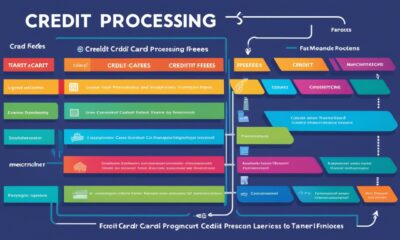
 Payment Processing2 weeks ago
Payment Processing2 weeks agoNavigating Merchant Services: Rates & Credit Card Fees
-

 Market Information Analyzed1 week ago
Market Information Analyzed1 week agoHow Do We Pick the Finest Ocean-Going Product Owner Considering All?
-

 Market Information Analyzed1 week ago
Market Information Analyzed1 week agoUnderstanding Copyright vs. Trademark Differences
-

 Market Information Analyzed1 week ago
Market Information Analyzed1 week agoWhat Are the Actual Digital Obligations Within Business?
-
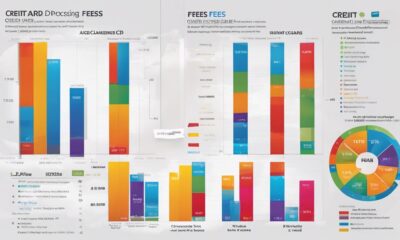
 Payment Processing1 week ago
Payment Processing1 week agoSide-by-Side Comparison: Credit Card Processing Interchange Fees
-

 Merchant Services2 weeks ago
Merchant Services2 weeks agoEssential Tips to Become an Internationale Org FAC29CR
-

 Payment Processing1 week ago
Payment Processing1 week agoSafeguarded Credit Card Processing With a Business Bank Account for Secure Online Transactions
-

 Market Information Analyzed1 week ago
Market Information Analyzed1 week ago7 Essential Security Tips for Service Providers to Shield Their Solutions From Thieves
















